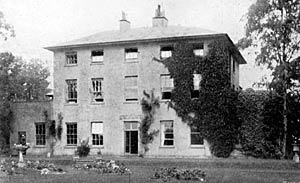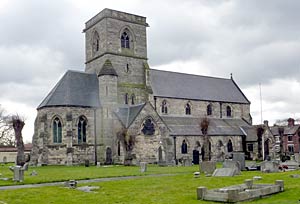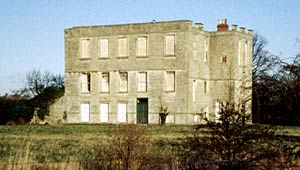< Previous | Contents | Next >
Stories on the Walls
SHELTON. Mantled in trees and bounded by the River Smite, this quiet home of a few people is part of a wide countryside which is golden in summertime with waving corn. It sees the sails of Elston's windmill, and hears the bells of Bottesford.

Shelton Hall, c.1900.

Shelton church in 2012.
© Copyright JThomas and licensed for reuse under this Creative Commons Licence

Fragment of Anglo-Saxon carved stone.
The big house and the small church look across a stretch of fine parkland, the lawn of the house and the churchyard coming in friendly fashion to low grey walls by the wayside. The house has two sundials and on the lawn is a great beech.
The church lost its old tower a century ago. The chancel is made new, but it has two 13th century lancets, and over the modern east window is the old hood adorned with heads. A charming row of three old lancets in the aisle has tinted glass shedding a mellow light, and above them is the medieval corbel table.
The arcade of slightly pointed arches on round pillars comes from about 1200. A face smiles from the rich hood of a lovely piscina in the aisle, and the 14th century font is like a chalice. There are two Jacobean coffin stools, and old work remains in the restored chancel screen. Its embattled cornice is fixed on to the wall above the wooden chancel arch. A modern door with beautiful ironwork hangs in the south doorway, which has in it parts of two Norman doorways.
The great treasures of Shelton are two exceptionally fine Saxon stones carved with knotwork, perhaps from two coped tombs. Fragments of old carved stones are built into the vestry wall, and in the churchyard is a stone coffin.
Vivid and tragic stories are told by some of the memorials in this tranquil place. One tells of the tragedy of Samuel Maltby and his wife in the Indian Mutiny. He was severely wounded while escaping down the Ganges, and was afterwards massacred at Bithor; his wife was taken from there to Cawnpore, where she was thrown into a well by order of Nena Sahib.
We read also of William Vere Smith, who died of fever at Bulawayo, going through two Matabele campaigns; of Francis Vere Wright who lost two fingers near Viterbo in 1860, "in the making of Italy"; and of Walter Banks Wright, who died in Benares from the heat. Another soldier of the Wright family has been lying since 1920 in the churchyard, a white cross carved with a sword and a belt marking his grave. The arms of a soldier of three centuries ago are carved on a stone set in a pillar of the arcade; he was William Warburton, a Royalist buried here in 1669.
Shelton's peace memorial cross in the churchyard is to one young man of 21, who fell in the last year of the war.
A Lost Tree's Three Counties

Church of St Luke, Shireoaks in 2011. © Copyright Andrew Hill and licensed for reuse under this Creative Commons Licence.

Shireoaks Hall in 1998. It was built in the early 17th century for the Hewet family.
SHIREOAKS. In the pleasantest part of this mining village the church stands by the wayside, shaded by limes. Built by the Duke of Newcastle in 1862, in 14th century style, it has a lofty tower with a short spire, aisles and an apse, and steep roofs painted in medieval colours.
Edward the Seventh, as Prince of Wales, laid the first stone, and he and Mr Gladstone gave some of the poor glass in memory of the duke who died two years after its building. Other memorials to him are the reredos, the sedilia, a table (all elaborately carved in marble and alabaster), and the mosaic lining the walls of the apse. The reredos has a group of 16 figures in the Crucifixion scene, also four angels, four saints, and symbols of the Evangelists.
Nothing is left of the ancient oak which gave the village its name, and threw its shade into Yorkshire, Derbyshire, and Notts. The boundary itself has changed, and the spot where it grew is now wholly in Notts. John Evelyn described the old tree as being 94 feet round, covering a patch of about 700 square yards.
